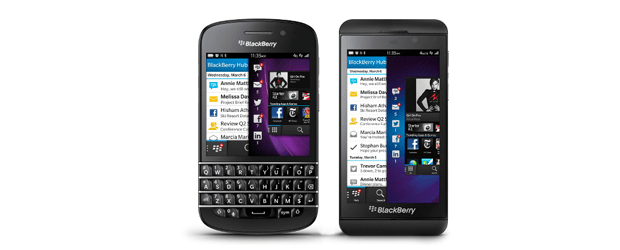ORLANDO — The stage at the opening of this year’s BlackBerry Live conference featured a lot of pricey wheels and celebrities.
They included a multimillion dollar racing car, a high-priced Bentley convertable, Formula 1 star racing driver Lewis Hamilton and rock star — and BlackBerry creative director and consultant — Alicia Keys.
Heins used the opportunity to toss in more than a few automotive metaphors to tout the fact that the company has finally launched the Z10 and Q10 handsets on the BB10 platform, and that financially the company was profitable last quarter (before taxes and deductions) after being in the red for some time.
“We have reached solid ground with this company,” he declared. “We are not only still here we are firing on all cylinders. We’re taking innovation to new levels. “We’re also taking new risks and we’re definitely in the race.”
Beyond the glitz was a fairly modest set of announcements from the company, which is steadily trying to climb back into the minds of buyers as a leading mobile manufacturer. They include:
- The promised update to BlackBerry Enterprise Service for mobile device management. Version 10.1 lets administrators not only oversee BlackBerrys, but also Android and Apple iOS devices.
- New “regulated-level” IT policy controls and settings for organizations in regulated industries who require advanced security of BlackBerry 10 smartphones. It also allows customers to support BlackBerry 10 and BlackBerry OS smartphones from a single server.
- For a limited time owners of lower versions of BES can upgrade to 10.1 free A
- new entry-level Q5 smart phone with a physical keyboard, but for selected countries in Europe, the Middle East, Africa, Asia-Pacific, and Latin America. It won’t be available in America
- A double boost for the BBM messaging service. Coming soon, users will be able to send messages to users of Android and Apple mobile devices.
More importantly for organizations, it will soon have enhanced social media support called Channels. These will let companies set up social networks within BBM to attract customers and supporters.
Similar to Twitter, subscribers can create a corporate or personal channel, with no limits to the number of followers. There’s also a carousel, or portal, for discovering new channels. Users can share channel invites within a BBM chat, and people can be added or invited using the channel’s PIN or QR code.
Channels is in beta for BlackBerry devices using operating systems 5 to 10.
Some 60 million BlackBerry subscribers use BBM, considered essential in nations where communications costs are high. It used to be popular in North American, but that has dropped as buyers turn to Android and Apple devices.
One question industry analysts here have been asking is whether, or how, BlackBerry can monetize the service given the number of users.
Charles Golvin, a principal analyst at Forrester Research, thinks the answer is yes. “One of the ways they could do it is through advertising through BBM Channels. But the other way they could do it is through corporate. So I think we’re going to see an evolution of BBM to a corporate service application that could eventually be a substitution for some of the unified communications toolsets that are used today.”
Other news included:
- The release of version 10.1 of BlackBerry Enterprise Service, the mobile device management suite, which includes support for Skype
- An update to BlackBerry Enterprise Instant Messaging. Version 3.0 now lets Z10/Q10 smartphone users securely communicate over Microsoft Lync, Microsoft Office Communication Server or IBM Lotus Sametime. It needs BES 10.1
- Keys announced a new BlackBerry Scholars Program, the first step in a global women’s initiative to inspire more women to enter science, technology, engineering and math careers. For more details on the program, click here.
Industry analysts admitted those were pretty low-key announcements, at least for North America. In regions where the Q5 is expected to be sold that handset will be quite significant.
Still, they said Heins’ keynote showed the steady-as-she goes approach of the CEO. Tim Shepherd, an analyst for Canalys who specializes in smart devices, noted the keynote should be seen in the context of how far BlackBerry has come in the last 12 months — the release of BlackBerry 10, the Z10 and Q10 handsets and a more stable company.
He was impressed that Heins said the BlackBerry applications market now has 120,000 apps which he said is “hugely important” because the size of the catalogue will attract users and developers to the BlackBerry platform.
As he did last year, Heins emphasized that the company is dedicated to making BlackBerry 10 not just an operating system for mobile devices but a mobile platform that will take the industry into the next era of mobile computing.
Enter the Bentley for a demonstration of how BlackBerry’s QNX operating system — which is the guts behind BB 10 — could be the heart of a vehicle as well. The concept car showed the system not only connecting to the car’s electronics but also to a BlackBerry device to allow in-car video-conferencing. (If the car is moving when a VC is detected it switches to audio-only mode).
But last year the demo featured a tricked-out Porche. Some believe QNX could be a significant revenue gainer for BlackBerry [TSX:BB] because it is being used in a number of industries — for example, a Mercedes-Benz executive told the show his company uses it for their in-vehicle entertainment system, but not for connecting to mobile devices.
Heins says his mobile platform vision will take a few years to materialize.




